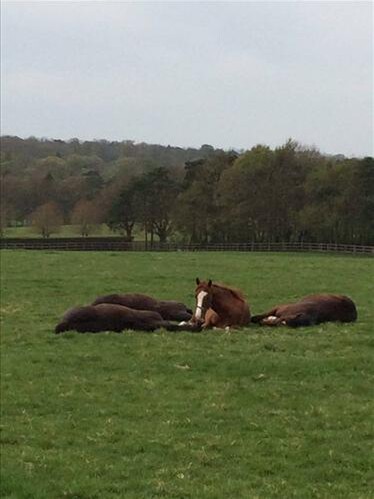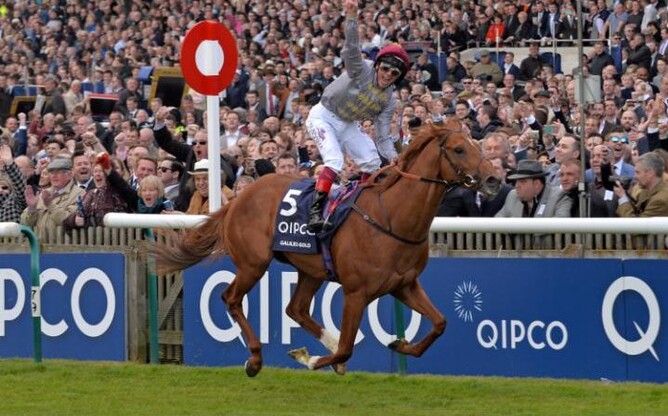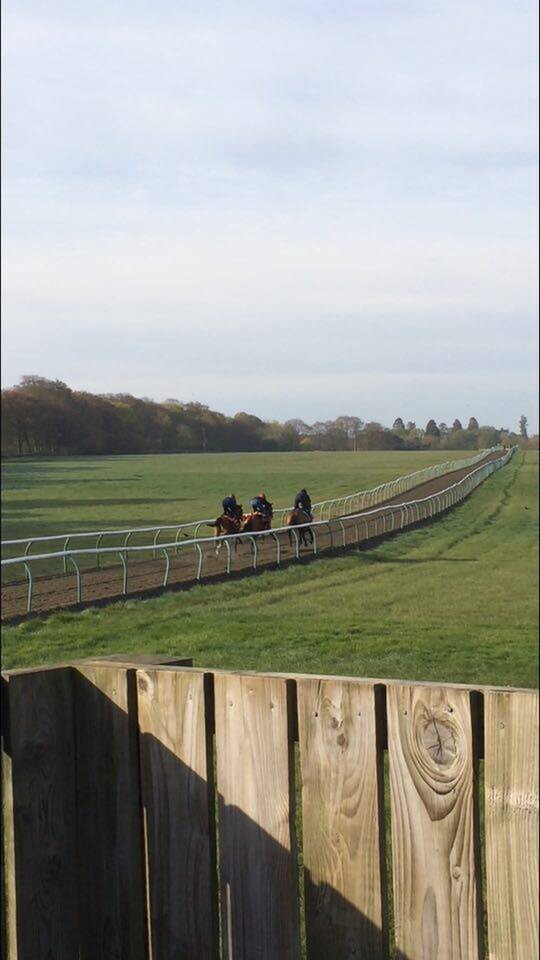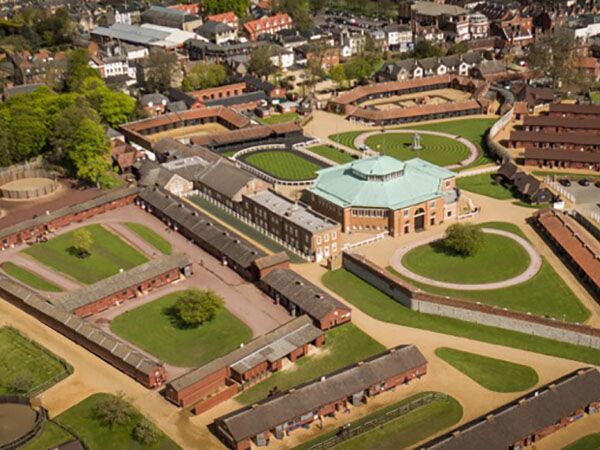A whirlwind first 10 weeks of the Sunline Scholarship has come and gone faster than I could have imagined.
It feels like just yesterday I nervously walked through the gates of Cheveley Park Stud, but nearly three months and 45 foals later my time has come to an end.
The picturesque and immaculately kept Cheveley Park Stud has been a great base for me and I really felt like part of the team. I have learnt a lot from their dedicated staff and I must thank them for everything they have done for me.
Since my last blog plenty has happened, including the weather warming up and me experiencing a British 'heatwave' (it reached 25 degrees!).
With the weather warming up the older mares and foals have started living outside full-time. In preparation for this we had to build an octagon pen in each paddock which had gaps in them big enough for only foals to get inside. This is a 'creep feeder' and allows the foals to eat feed without having to compete with mares.
The flat racing season has begun in the UK and Cheveley Park Stud's first season sire, Mayson, has started with a bang already siring two winners including a winner on 1000 Guineas Day at Newmarket.
I was lucky enough to attend both the Group 1 2000 Guineas (raced on the Saturday) and the Group 1 1000 Guineas (raced on the Sunday) at the famous Rowley Mile racecourse. Big crowds gathered for both days and it was clear to see why with the horse flesh that was on show.
It feels like just yesterday I nervously walked through the gates of Cheveley Park Stud, but nearly three months and 45 foals later my time has come to an end.
The picturesque and immaculately kept Cheveley Park Stud has been a great base for me and I really felt like part of the team. I have learnt a lot from their dedicated staff and I must thank them for everything they have done for me.
Since my last blog plenty has happened, including the weather warming up and me experiencing a British 'heatwave' (it reached 25 degrees!).
With the weather warming up the older mares and foals have started living outside full-time. In preparation for this we had to build an octagon pen in each paddock which had gaps in them big enough for only foals to get inside. This is a 'creep feeder' and allows the foals to eat feed without having to compete with mares.
The flat racing season has begun in the UK and Cheveley Park Stud's first season sire, Mayson, has started with a bang already siring two winners including a winner on 1000 Guineas Day at Newmarket.
I was lucky enough to attend both the Group 1 2000 Guineas (raced on the Saturday) and the Group 1 1000 Guineas (raced on the Sunday) at the famous Rowley Mile racecourse. Big crowds gathered for both days and it was clear to see why with the horse flesh that was on show.
The Group 1 2000 Guineas was won by Galileo Gold for Hugo Palmer who is making a big impression as a trainer. The colt is by former Waikato Stud sire Paco Boy who shuttled to New Zealand in 2011.
Sunday's Group 1 1000 Guineas saw one of the greatest trainers in the world dominate with Aiden O'Brien producing the trifecta with all three fillies by champion sire Galileo. It was race-favourite Minding that was victorious and she looks to be the best filly in Europe at this stage.
The Guineas races were the second time I had visited the Rowley Mile having attended breeze ups for Tattersalls' Craven Breeze Up Sale for two-year-olds on the track a few weeks earlier. I spent four days with local bloodstock agent Alex Elliot attending the Sale.
I found the breeze up sale in the UK fascinating and very different to NZB's Ready to Run Sale. The biggest difference is that they breezed up the day before they sold whereas we breeze up a month before going under the hammer.
Breezing up the day before the sale means that the horses are fit and look ready to race, and many were ready to race as less than a month after the sale there were winners out of the sale.
Consignors presented horses that were definite two-year-old types and the majority of sires were either proven juvenile sires or young sires who were good two-year-olds themselves, with sires such as Southern Hemisphere's Sepoy and Helmet represented.
Many agents, trainers and prospective buyers attend the breeze up. There is no official timing of the gallops so buyers have to collect their own information. Alex had partnered with some other agents to time the horses, recording times for two furlongs (400m) and one furlong (200m).
My task at the breeze up was to observe the 'follow out'. What is the 'follow out'? It is how the horse travels and pulls up after it has crossed the finishing line. One of the most important things I was observing was if the horses were making any sounds that would indicate a wind issue along with judging how quickly they pulled up.
Back at the sale grounds, we inspected horses the day prior to the breeze, the afternoon after the breeze and the following day which was sale day. With a catalogue of only 170 there wasn't too many to get around once a shortlist was made from pedigree and breeze ups. Selling began at 6pm each day with 85 lots catalogued for each day.
Alex was able to purchase one horse, a colt by Quality Road, who was a lovely big horse and will make a nice three-year-old. He had a client that he wanted to buy a two-year-old for and had a healthy budget to do so. He was under bidder on five horses, going to at least 200,000 pounds on each occasion. It was frustrating to keep missing out due to good judges with plenty of money liking the same horses as we did.
I thoroughly enjoyed attending the sale and made many observations of how Europeans approach two-year-olds sales and have ideas on how to apply them to our Ready to Run Sale.
Sunday's Group 1 1000 Guineas saw one of the greatest trainers in the world dominate with Aiden O'Brien producing the trifecta with all three fillies by champion sire Galileo. It was race-favourite Minding that was victorious and she looks to be the best filly in Europe at this stage.
The Guineas races were the second time I had visited the Rowley Mile having attended breeze ups for Tattersalls' Craven Breeze Up Sale for two-year-olds on the track a few weeks earlier. I spent four days with local bloodstock agent Alex Elliot attending the Sale.
I found the breeze up sale in the UK fascinating and very different to NZB's Ready to Run Sale. The biggest difference is that they breezed up the day before they sold whereas we breeze up a month before going under the hammer.
Breezing up the day before the sale means that the horses are fit and look ready to race, and many were ready to race as less than a month after the sale there were winners out of the sale.
Consignors presented horses that were definite two-year-old types and the majority of sires were either proven juvenile sires or young sires who were good two-year-olds themselves, with sires such as Southern Hemisphere's Sepoy and Helmet represented.
Many agents, trainers and prospective buyers attend the breeze up. There is no official timing of the gallops so buyers have to collect their own information. Alex had partnered with some other agents to time the horses, recording times for two furlongs (400m) and one furlong (200m).
My task at the breeze up was to observe the 'follow out'. What is the 'follow out'? It is how the horse travels and pulls up after it has crossed the finishing line. One of the most important things I was observing was if the horses were making any sounds that would indicate a wind issue along with judging how quickly they pulled up.
Back at the sale grounds, we inspected horses the day prior to the breeze, the afternoon after the breeze and the following day which was sale day. With a catalogue of only 170 there wasn't too many to get around once a shortlist was made from pedigree and breeze ups. Selling began at 6pm each day with 85 lots catalogued for each day.
Alex was able to purchase one horse, a colt by Quality Road, who was a lovely big horse and will make a nice three-year-old. He had a client that he wanted to buy a two-year-old for and had a healthy budget to do so. He was under bidder on five horses, going to at least 200,000 pounds on each occasion. It was frustrating to keep missing out due to good judges with plenty of money liking the same horses as we did.
I thoroughly enjoyed attending the sale and made many observations of how Europeans approach two-year-olds sales and have ideas on how to apply them to our Ready to Run Sale.
Another interaction with horses with saddles on their back came when I visited leading trainer William Haggas for a morning.
I arrived at Somerville Lodge at 6am (trackwork starts a lot later in the UK) on a Thursday morning which was a gallop day. Horses go out in 'strings' with about 40-50 horses going out together in a string. There were four strings going out on the morning I was there.
The work is very different to back in NZ and horses galloped up heaths in twos, threes or fours. The heaths are all uphill and the horses are asked to work hard at the steepest sections. The horses here a very fit and strong as result of this kind of work.
Pacework is also done on uphill heaths. I saw two-year-olds pace working up steep heaths with the progressed horses doing two climbs up short but steep heaths. The horses all appeared to enjoy the work.
That was one of the things I took away from my time with Mr Haggas - a horse must be happy. His training is all based around keeping a horse happy and enjoying its work and that will lead to racetrack performance. With plenty of success to back him up, it is a formula that seems to work.
I arrived at Somerville Lodge at 6am (trackwork starts a lot later in the UK) on a Thursday morning which was a gallop day. Horses go out in 'strings' with about 40-50 horses going out together in a string. There were four strings going out on the morning I was there.
The work is very different to back in NZ and horses galloped up heaths in twos, threes or fours. The heaths are all uphill and the horses are asked to work hard at the steepest sections. The horses here a very fit and strong as result of this kind of work.
Pacework is also done on uphill heaths. I saw two-year-olds pace working up steep heaths with the progressed horses doing two climbs up short but steep heaths. The horses all appeared to enjoy the work.
That was one of the things I took away from my time with Mr Haggas - a horse must be happy. His training is all based around keeping a horse happy and enjoying its work and that will lead to racetrack performance. With plenty of success to back him up, it is a formula that seems to work.
Another visit I made was to Brook Stud operated by Dwayne and Wendyll Woods. I was put in touch with Dwayne by NZ Bloodstock Agent, Guy Mulcaster and had a tour of Brook Stud. They had quality stock with foals by some the best sires that were all in outstanding condition - the farm do a very professional job.
While I was there I got to see a favourite kiwi racemare -Silent Achiever. The champion mare looked very well and is in foal to the highest rated horse to ever race, Frankel. It was a privilege to see the great mare and I am sure she enjoyed hearing a kiwi voice again.
The following week I had a behind the scenes tour of the English National Stud with Brian O'Rourke. The English National Stud has a rich history and was found by The Jockey Club. One of the most interesting facts was that Mill Reef, a champion racehorse and a sire that appears in many pedigrees these days was gifted to the Stud upon retiring from racing. A champion on the track like that would fetch tens of millions of dollars in the modern day. At one point, he commanded a service fee which was equivalent to about 400,000 pounds, half of which had to be paid before the mare was served and was not refunded even if the mare was not in foal.
I actually spent a bit of time at the English National Stud as I have been attending lectures twice a week in the evenings. When I left university in 2010 I never thought I'd step foot in a lecture room again but this time around I was a much more diligent student (I didn't fall asleep once!).
While a lot of the teachings were about things I have seen and experienced it was very interesting to see and hear in depth explanations. We even got to cut a leg up and examine how all the tendons and ligaments are connected.
During my final week I managed to spend some time with the marketing team at Tattersalls. It had been a busy time of year for them with various sales and major race meetings. I first met with Melissa Jordan who took me through the role she does with the company. It was very interesting listening to how Tattersalls do things and comparing it to my time at NZB.
While I was there I got to see a favourite kiwi racemare -Silent Achiever. The champion mare looked very well and is in foal to the highest rated horse to ever race, Frankel. It was a privilege to see the great mare and I am sure she enjoyed hearing a kiwi voice again.
The following week I had a behind the scenes tour of the English National Stud with Brian O'Rourke. The English National Stud has a rich history and was found by The Jockey Club. One of the most interesting facts was that Mill Reef, a champion racehorse and a sire that appears in many pedigrees these days was gifted to the Stud upon retiring from racing. A champion on the track like that would fetch tens of millions of dollars in the modern day. At one point, he commanded a service fee which was equivalent to about 400,000 pounds, half of which had to be paid before the mare was served and was not refunded even if the mare was not in foal.
I actually spent a bit of time at the English National Stud as I have been attending lectures twice a week in the evenings. When I left university in 2010 I never thought I'd step foot in a lecture room again but this time around I was a much more diligent student (I didn't fall asleep once!).
While a lot of the teachings were about things I have seen and experienced it was very interesting to see and hear in depth explanations. We even got to cut a leg up and examine how all the tendons and ligaments are connected.
During my final week I managed to spend some time with the marketing team at Tattersalls. It had been a busy time of year for them with various sales and major race meetings. I first met with Melissa Jordan who took me through the role she does with the company. It was very interesting listening to how Tattersalls do things and comparing it to my time at NZB.
I then met with Jason Singh who looks after their digital department, amongst many other things. I was probably overly excited talking websites and their intricacies. While talking to Jason it dawned on me, I have become a tiny bit of a computer geek! I still wouldn't consider myself a true tech-head though.
My time in Newmarket wrapped with me entering the 2016 Heath Challenge Race on my penultimate day. It was a 6km run around the steep heaths I talked about earlier. Now, I haven't run since I did a half-marathon in August of last year and was only convinced to run on the day of the race so had no training whatsoever.
I fell out of the barriers and was at the tail of the field to begin with, beaten for speed early like a hardy old stayer. After the mad early rush the field started to come back to me and I decided to make a mid-race move. Improving my position all the time, I entered the final kilometre with Cheveley Park Stud's gun 19-year-old runner Connor in my sights. I flashed home from a hopeless position to run past Connor, hitting the line strongly for a respectable 79th position finish (out of 200).
The run had 'next up' written all over it - I was a stayer resuming after a long injury break who ran on well. Many form analysts and punters who were there put me in the black book for my next start. However, I pulled up very sore the following day, this old stayer had somehow gone shin sore and as a result has once again been retired from racing.
So that about sums up my time in Newmarket. I have had a truly great time in the birthplace of racing. Someone said to me during my time "you are living in history" and it is clear to see as you look around that those words are true.
The experience and knowledge I have gained in the UK is invaluable and I have met some great people along the way, making my time all the better. I need to take this chance to thank all the people in Newmarket who have helped me, I have made friends for life and I hope to see many of you again in the future.
Now to Ireland (I hear the weather is even more tropical there).
Bevan out!
My time in Newmarket wrapped with me entering the 2016 Heath Challenge Race on my penultimate day. It was a 6km run around the steep heaths I talked about earlier. Now, I haven't run since I did a half-marathon in August of last year and was only convinced to run on the day of the race so had no training whatsoever.
I fell out of the barriers and was at the tail of the field to begin with, beaten for speed early like a hardy old stayer. After the mad early rush the field started to come back to me and I decided to make a mid-race move. Improving my position all the time, I entered the final kilometre with Cheveley Park Stud's gun 19-year-old runner Connor in my sights. I flashed home from a hopeless position to run past Connor, hitting the line strongly for a respectable 79th position finish (out of 200).
The run had 'next up' written all over it - I was a stayer resuming after a long injury break who ran on well. Many form analysts and punters who were there put me in the black book for my next start. However, I pulled up very sore the following day, this old stayer had somehow gone shin sore and as a result has once again been retired from racing.
So that about sums up my time in Newmarket. I have had a truly great time in the birthplace of racing. Someone said to me during my time "you are living in history" and it is clear to see as you look around that those words are true.
The experience and knowledge I have gained in the UK is invaluable and I have met some great people along the way, making my time all the better. I need to take this chance to thank all the people in Newmarket who have helped me, I have made friends for life and I hope to see many of you again in the future.
Now to Ireland (I hear the weather is even more tropical there).
Bevan out!






